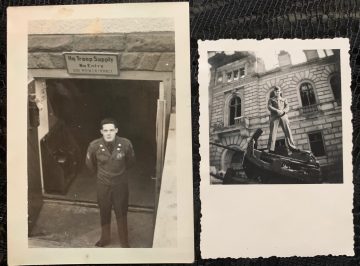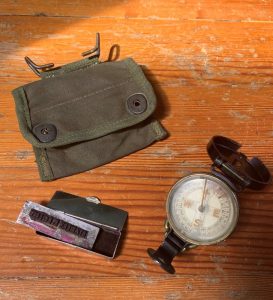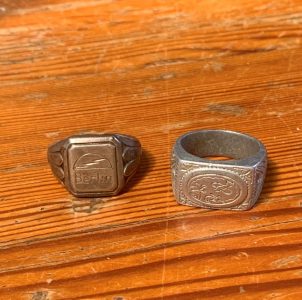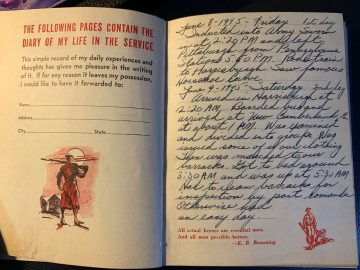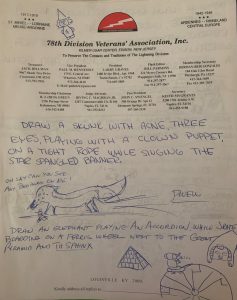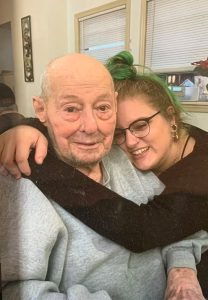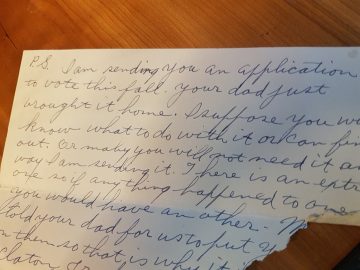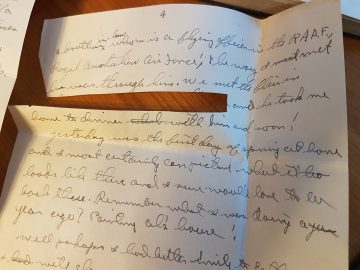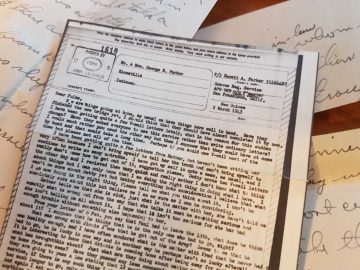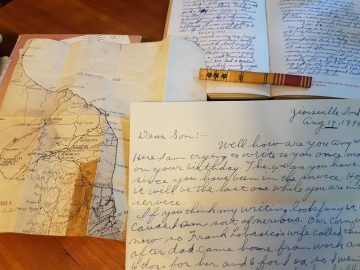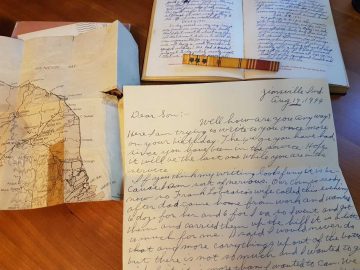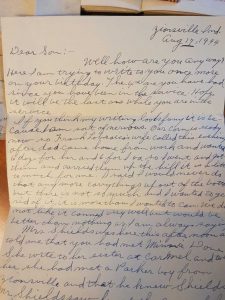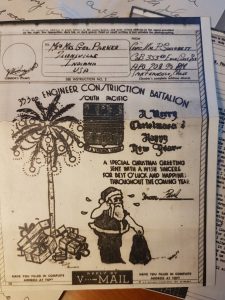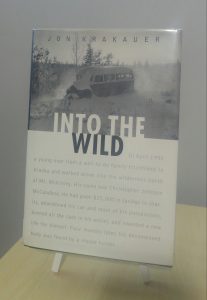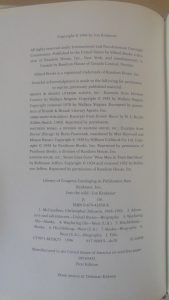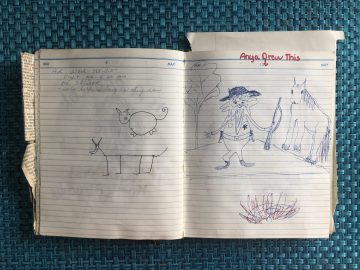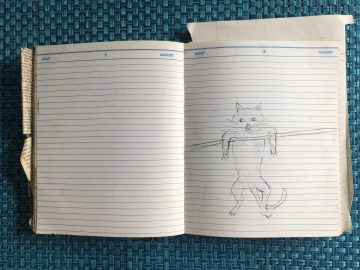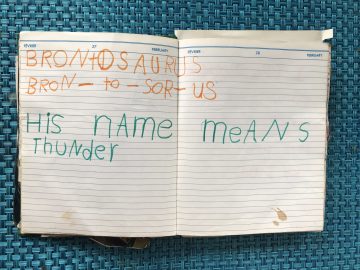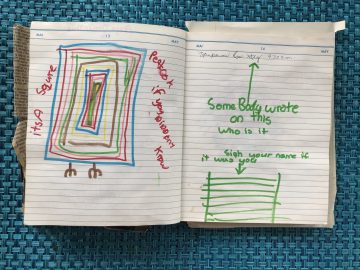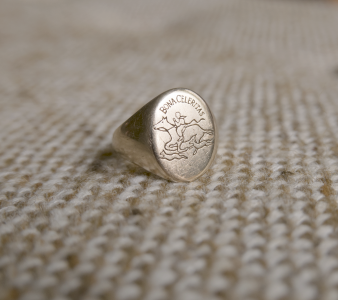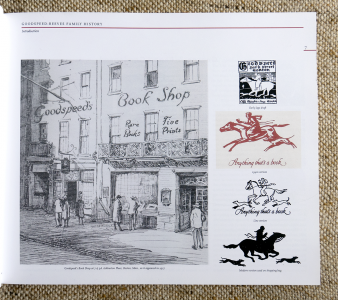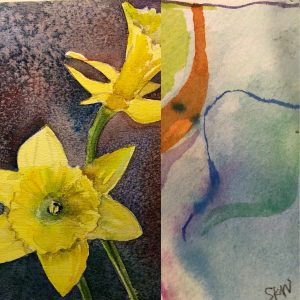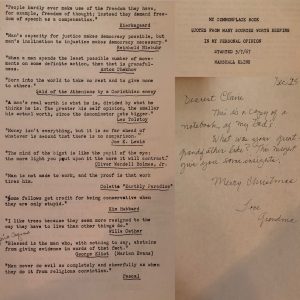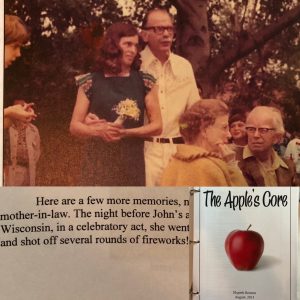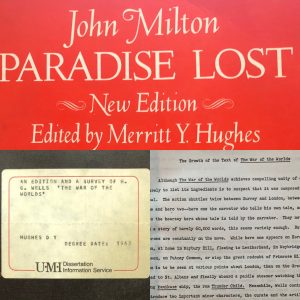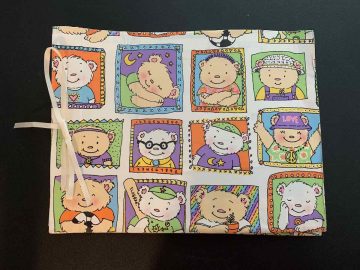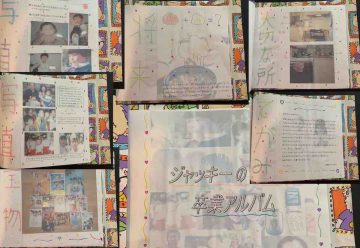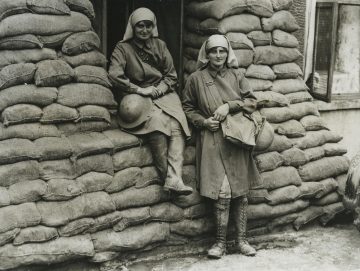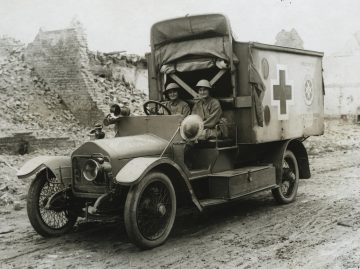Personal library/archives show and tell (VI)
Posted on August 4, 2020 @4:56 pm by cshriver
Show and Tell: Selections from our Personal Archives and Libraries
How we remember, and what we hold dear, differs from person to person. All of us have personal archives we keep to preserve memories that are precious, that document our families, our histories and record important events. It could be a simple piece of ephemera we love and cannot part with (a ticket stub from our first concert, for example), or photographs of ancestors that offer clues to our origins, or anything we have set aside and saved for a myriad reasons. Similarly, our personal libraries hold volumes that have emotional value to us, not just for the words contained in it, but as a reflection of a time in our lives, we found them particularly relevant. This could be the first book of poetry that made us fall in love with verse, or the dog-eared copy of a classic novel that led us to our current passion for libraries and library work. This blog series explores selections from the personal libraries and archives of members of the Rare Books and Special Collections team, and other colleagues from UBC Library and beyond. We hope our stories will help you reflect on what is meaningful at this time in your, and in our, collective histories.
— Krisztina Laszlo, Archivist
Weiyan Yan, Office, Copying & Shelving Assistant
In her late teens, my mother was a nurse at a hospital in Xi’an city. After she moved to my father’s hometown – a small village on the Loess Plateau – she became a doctor and a midwife. At that time in China, people called this kind of doctor “Barefoot Doctor”. That meant they were farmers but they were also doctors in their spare time. Even I’m not sure about the qualifications. She said that she was “a flagpole pulled out from a bunch of chopsticks”. But as far as I know, she did a very good job, especially at being a midwife. I still remember that she had a red bag for being a doctor. It was the most important thing in our house and we never were allowed to touch it.
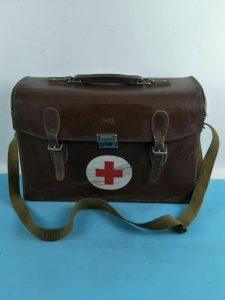
Chinese medicine bag
I don’t know how many patients she had seen, but I know that from late 1950s to late 1990s, she delivered most of the babies in our village, the parents and then their children, except a few that she felt should be delivered in the hospital. She was well respected and she became an older sister-in-law to many people in our village. That was confusing! They called her sister-in-law out of respect, and I called them grandparents or great grandparents because of the hierarchy in our society.
I have many memories from when she was working. In the middle of the crazy, cold, winter night, someone looking for my mother’s help would loudly knock on our front door or back door, or sometimes even both doors; everybody in my family woke up. My mother would take her medicine bag and leave with them right away. Most of the time, she would come back the second morning with a few thin, dry pancakes. I would have a piece of them and squat beside her to watch her washing her rubber gloves. I forget most of the details, and only remember that she turned them over, blew some air in, tied the open side with one hand, and squished with the other hand. It was so amazing to me at that time that the fingers would come out one by one with popping sounds. Sometimes my father might come by and offer to bite my pancake into the shape of a horse – I was born in the year of the horse. I was really happy at first and then cried when there was only a small piece left.
My mother was a city girl. After she moved to the village, she learnt everything about being a farmer, or being a woman on a farm. She spun, wove, made clothes and shoes for us. But the soles that she made were never good. She used a hammer to make them flat on a piece of stone.
I was proud of my mother, but not always. When she came to our school for the immunizations, I was always the first one to get an injection in order to set a good example for the other kids, even though I was also very scared. When she dressed up and played a bad woman on stage, I was so embarrassed in front of my friends. I wanted her to play a hero. But I never discussed that with her. I was a good girl at that time.
My mother has been gone for many years. Each time when I’m thinking of her, I always picture her with her red medicine bag, coming to me with a smile.
Natalie Trapuzzano, Student Archives and Reference Assistant
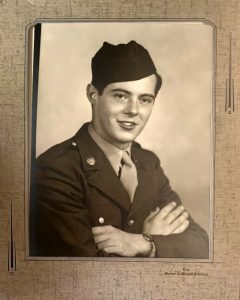
Stushie’s headshot in uniform.
I can say without any hint of humor or irony that one of my best friends is a ninety-three-year-old man. My great-uncle Stushie (Stanley, if you’re being stern) is my hands-down favorite person. A proud WWII veteran, history buff, perennial jokester, and armchair Jeopardy champion, he’s been the most consistent and inspiring man in my life. Even though he was a high school dropout, he’s the most intelligent and well-read person I know and always encouraged me to work toward the same. He bought me annual subscriptions to National Geographic and Smithsonian Kids magazines until I got old enough for the “adult” versions that he still sends me today—and no one leaves his house without a bag full of random items to go. He’s a bit of a packrat and his favorite topic of discussion is his experience in Europe during WWII, so he’s given me a lot of his military-related photos and ephemera over the years. He recently had to move to an assisted living facility, and I’ve been worrying about him a lot because of the pandemic’s impact on seniors in the United States, so it’s nice to have some of his treasures around while I can’t be with him in person.
- Some snapshots from his time in Europe. Notations on the back: “Some more clowning around” (left); “Me, standing on an AA Gun with what’s left of the Propaganda Ministry in back” (right).
- A canvas pouch that was part of his military uniform, as well as a compass and his personalized stamper that were carried within it.
- A ring bearing the symbol of the 78th Infantry Division from his time in Berlin & a hand-poked ring his brother Leonard traded a pack of cigarettes for while stationed in Africa during WWII.
- A page from his military diary, begun June 8th, 1945.
- One of our favorite pastimes: making the other person draw increasingly ridiculous pictures.
- Natalie and Stushie
No Comments
Posted in Collections, Exhibitions, Frontpage Exhibition, Research and learning | Tagged with show and tell
Personal library/archives show and tell (V)
Posted on July 27, 2020 @4:31 pm by cshriver
Show and Tell: Selections from our Personal Archives and Libraries
How we remember, and what we hold dear, differs from person to person. All of us have personal archives we keep to preserve memories that are precious, that document our families, our histories and record important events. It could be a simple piece of ephemera we love and cannot part with (a ticket stub from our first concert, for example), or photographs of ancestors that offer clues to our origins, or anything we have set aside and saved for a myriad reasons. Similarly, our personal libraries hold volumes that have emotional value to us, not just for the words contained in it, but as a reflection of a time in our lives, we found them particularly relevant. This could be the first book of poetry that made us fall in love with verse, or the dog-eared copy of a classic novel that led us to our current passion for libraries and library work. This blog series explores selections from the personal libraries and archives of members of the Rare Books and Special Collections team, and other colleagues from UBC Library and beyond. We hope our stories will help you reflect on what is meaningful at this time in your, and in our, collective histories.
— Krisztina Laszlo, Archivist
Susan Parker, University Librarian
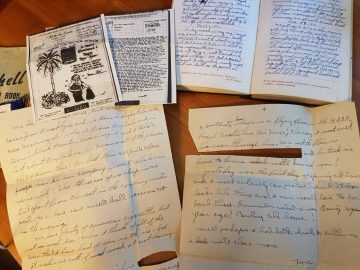
V-mail form and censored letters
When I was growing up, I knew my father had been in the U.S. Army in Papua New Guinea during World War II. Like many veterans of that war, he seldom spoke about it, and usually it was only when he was indisposed with recurring symptoms of malaria, which he contracted there. He died suddenly, a few months after I graduated from college, and only then did I learn more from my mother. She told me that Dad was in the Army Graves Registration Service. His team retrieved Allied soldiers’ remains, identified them, and buried them there in the jungle until they could be sent home.
What’s included here are letters to my dad, some from his father and some from his mother, from summer, 1944. There are also letters home from my dad to them, mostly from 1942 and 1943. Some of my dad’s letters are hand written, including those with portions of them cut out by censors. Most are typed on Army forms called V-mail.
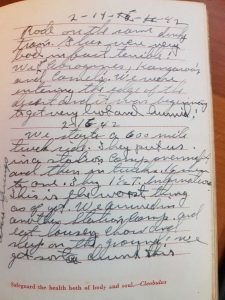
Emmett Parker diary
There are two diaries here, one provided to soldiers by the Army and one is just a blank notebook. My dad enlisted on December 8, 1941, the day after Pearl Harbor. His diaries detail his deployment with the 808th Engineer Aviation Battalion from San Francisco by boat to Melbourne, Australia, and by train and truck through the Australian desert to Darwin, and from there, to Port Moresby, New Guinea. He spent most of the war on the opposite side of that island, at Camp Pine Creek, near the village of Buna.
The Engineers were sent to New Guinea to build desperately needed airstrips for Allied bombers. A small and heavily folded map from the time is included; my dad must have kept that to show at home after the war. One of his diaries details his survival through the Battle of Buna, a grisly and costly fight for both sides, lasting from July 1942 until January 1943, when U.S. and Australian air and land troops finally defeated the Japanese occupation of New Guinea.
You’ll also see here two uniform patches. These designate the Second Service Command. I don’t know much detailed information about these decorations or Dad’s rank (Corporal); his service records were among the thousands that were destroyed in the NARA Military Archives fire in 1973. I can identify three medals designated by the ribbons here. On the left is the Defense Service Medal with three stars, one for each year of combat deployment. In the middle the Asiatic-Pacific Campaign medal designates his South Pacific service, and the red ribbon on the right is a Good Conduct medal, also reflecting three years of active service or more.
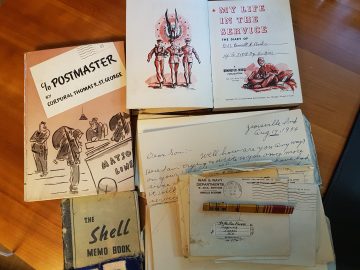
Uniform patch (right) and “c/o Postmaster” book (left)
There’s also a book, c/o Postmaster, which my dad relished as a reminiscence of another soldier’s Army experiences while serving in Australia.
These letters, correspondence between my dad and his parents, are a link to my grandfather, who I never knew, and a window into my grandparents’ life on the home front in rural Zionsville, Indiana with my dad’s 15-year-old brother and their newly-married older sister.
This little collection is a vivid connection to my dad’s World War II experiences, giving me a small window into what he lived through and the gruesome job he performed. I had the good fortune to travel to Australia last year. Although I did not get to New Guinea or to Darwin, my dad’s favorite Australian town to visit while on liberty, it was meaningful to me to be there. I spent several days in Melbourne last summer with thoughts of him and the war.
Posted in Collections, Exhibitions, Frontpage Exhibition, Research and learning | Tagged with show and tell
Personal library/archives show and tell (IV)
Posted on July 20, 2020 @4:58 pm by cshriver
Show and Tell: Selections from our Personal Archives and Libraries
How we remember, and what we hold dear, differs from person to person. All of us have personal archives we keep to preserve memories that are precious, that document our families, our histories and record important events. It could be a simple piece of ephemera we love and cannot part with (a ticket stub from our first concert, for example), or photographs of ancestors that offer clues to our origins, or anything we have set aside and saved for a myriad reasons. Similarly, our personal libraries hold volumes that have emotional value to us, not just for the words contained in it, but as a reflection of a time in our lives, we found them particularly relevant. This could be the first book of poetry that made us fall in love with verse, or the dog-eared copy of a classic novel that led us to our current passion for libraries and library work. This blog series explores selections from the personal libraries and archives of members of the Rare Books and Special Collections team, and other colleagues from UBC Library and beyond. We hope our stories will help you reflect on what is meaningful at this time in your, and in our, collective histories.
— Krisztina Laszlo, Archivist
Stephanie Plumb, Library Services Assistant – Records Management
I can trace my journey from Arizona to British Columbia back to a single, defining moment: when I purchased a copy of Into the Wild by Jon Krakauer in 2007. The book cover looked interesting, and advertised that it had been made into a feature film. As I devoured the story of Chris McCandless, a 20-something year old who goes off the grid to connect with nature and journey to Alaska, all of my Thoreauean sensibilities were awakened and I knew I had to follow in suit. I quit my job, packed my car, and set out for a 3-month long road trip from Phoenix to Talkeetna, Alaska. There, in the shadow of Denali, I met my future Canadian husband at a local hostel. The same story had inspired him to travel to Alaska. Five years later, after much city-hopping, backpacking, and immigration paper filing, I landed in Kelowna as a Canadian permanent resident. In 2014, I was gifted this first-edition copy of Into the Wild, which holds a place of honor on my bookshelf. Though many years have gone by and I have learned how to temper my wanderlust, when I hear Eddie Vedder crooning “Big Hard Sun” from the Into the Wild soundtrack, I look off to the horizon, aware of the itch in my feet.
Posted in Collections, Exhibitions, Frontpage Exhibition, Research and learning | Tagged with show and tell
Personal library/archives show and tell (III)
Posted on July 13, 2020 @3:27 pm by cshriver
Show and Tell: Selections from our Personal Archives and Libraries
How we remember, and what we hold dear, differs from person to person. All of us have personal archives we keep to preserve memories that are precious, that document our families, our histories and record important events. It could be a simple piece of ephemera we love and cannot part with (a ticket stub from our first concert, for example), or photographs of ancestors that offer clues to our origins, or anything we have set aside and saved for a myriad reasons. Similarly, our personal libraries hold volumes that have emotional value to us, not just for the words contained in it, but as a reflection of a time in our lives, we found them particularly relevant. This could be the first book of poetry that made us fall in love with verse, or the dog-eared copy of a classic novel that led us to our current passion for libraries and library work. This blog series explores selections from the personal libraries and archives of members of the Rare Books and Special Collections team, and other colleagues from UBC Library and beyond. We hope our stories will help you reflect on what is meaningful at this time in your, and in our, collective histories.
— Krisztina Laszlo, Archivist
Barbara Towell, E-Records Manager, University Archives
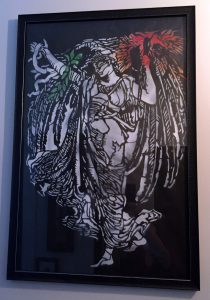 In 2013 my apartment building in Mount Pleasant was sold and the fate of the occupants was in peril. The building was full of long-term tenants enjoying relatively inexpensive rent and now it seemed certain that we would be evicted, our apartments renovated, and the rents tripled. One evening, my partner and I noticed the appearance of a sandwich board in front of the building that seemed to be advertising a shop or service of some kind. For a few hours in the evening, it would show up, then disappear, only to reappear the following evening. This continued for a week or two. It contained no words, only the image of an oddly familiar angel with an outstretched arm gesturing toward our building. I tried to understand what it was advertising. After obsessing over where I had seen that winged creature before, I recalled a class I had taken during my undergrad and after a bit on time on the internet I realized that this image was a reference to a woodcut by Walter Crane called “To the memory of the Paris Commune” (1871), which memorializes the death of thousands of Communards killed by the French army. The sandwich board seemed to signal a dim future for the tenants occupying our, and so many other, rental buildings across Vancouver. Then as quickly as it appeared, it vanished, and I never saw it on the sidewalk in front of the building again.
In 2013 my apartment building in Mount Pleasant was sold and the fate of the occupants was in peril. The building was full of long-term tenants enjoying relatively inexpensive rent and now it seemed certain that we would be evicted, our apartments renovated, and the rents tripled. One evening, my partner and I noticed the appearance of a sandwich board in front of the building that seemed to be advertising a shop or service of some kind. For a few hours in the evening, it would show up, then disappear, only to reappear the following evening. This continued for a week or two. It contained no words, only the image of an oddly familiar angel with an outstretched arm gesturing toward our building. I tried to understand what it was advertising. After obsessing over where I had seen that winged creature before, I recalled a class I had taken during my undergrad and after a bit on time on the internet I realized that this image was a reference to a woodcut by Walter Crane called “To the memory of the Paris Commune” (1871), which memorializes the death of thousands of Communards killed by the French army. The sandwich board seemed to signal a dim future for the tenants occupying our, and so many other, rental buildings across Vancouver. Then as quickly as it appeared, it vanished, and I never saw it on the sidewalk in front of the building again.
A maquette of the work made a reappearance some time later at an impromptu art sale held in the building’s lobby. While I was sad about what was happening to the tenants of my building, and obviously, our destiny was nothing compared to what the actual Communards received in 1871, I was excited to see a maquette of the sandwich board for sale and to learn who had created it. I bought the work, and this may have been the artist’s first sale, as he seemed both embarrassed and uncomfortable with the transaction. When asked, he was unable to tell me the price. After a few uneasy seconds, I made an offer which caused him to shift in his seat, but he accepted. The image is by Colin Fraser, spray paint on paper [81 x 51 cm]. It is from a time when I knew the names of all my neighbours. The sandwich board’s nightly position on the sidewalk did nothing to undermine our certain eviction, but nevertheless represented resistance, and one tenant’s silent nightly protest.
Krisztina Laszlo, Archivist
My parents were refugees of the Hungarian Revolution, and struggled in different ways to adjust to life in Canada. They left for different reasons; my dad because he took part in the resistance, and to stay would have meant severe repercussions and possible death. My mom left when her best friend suggested they join the stream of people heading for the Austrian border. Toiling in the soviet factory system together did not seem palatable when there was a glimmer of hope in escaping to the promise of a better life. My parents met on Vancouver Island, part of a small community of Hungarian refugees adapting to the culture in Canada, learning English, and establishing new roots. We did not have much growing up, and out of both preference and necessity, we raised or grew most of our own food. We even made soap out of pig fat! My dad worked in construction, and doing odd jobs, while my mom with only an education to age 14, mainly took cleaning jobs so she could buy the extra things we could not make ourselves. For much of my early childhood, she would leave five nights a week to an office building in downtown Victoria. This job meant an endless supply of craft and art supplies. She would bring home old file folders, expired diaries and ledgers, and other discarded detritus that was much prized for my many creative projects.
One item I still have from this period is a 1975 hardbound appointment book that had seen minimal use by its original owner. I filled the pages with my childhood scribbles and drawings, practiced my printing and pasted in and collaged images cut out from old magazines. What makes the book precious to me now is that it also contains a few sketches by my anya (“mom” in Hungarian), that I have a clear memory of asking her to do. My favourite is a pencil sketch of a cat hanging off a pole, based on the classic 1970s “Hang in there” imagery. And that is what she did, she hung in there and gave me the opportunity to have a life free of the challenges she faced. She died in 2019, but I am forever grateful for this reminder of her strength and endurance.
Posted in Collections, Exhibitions, Frontpage Exhibition, Research and learning | Tagged with show and tell
Show and tell with the RBSC team, part II
Posted on July 6, 2020 @5:16 pm by cshriver
Show and Tell: Selections from our Personal Archives and Libraries
How we remember, and what we hold dear, differs from person to person. All of us have personal archives we keep to preserve memories that are precious, that document our families, our histories and record important events. It could be a simple piece of ephemera we love and cannot part with (a ticket stub from our first concert, for example), or photographs of ancestors that offer clues to our origins, or anything we have set aside and saved for a myriad reasons. Similarly, our personal libraries hold volumes that have emotional value to us, not just for the words contained in it, but as a reflection of a time in our lives, we found them particularly relevant. This could be the first book of poetry that made us fall in love with verse, or the dog-eared copy of a classic novel that led us to our current passion for libraries and library work. This blog series explores selections from the personal libraries and archives of members of the Rare Books and Special Collections team, and perhaps other colleagues from UBC Library and beyond. We hope our stories will help you reflect on what is meaningful at this time in your, and in our, collective histories.
— Krisztina Laszlo, Archivist
Hiller Goodspeed, Circulation, Copying and Shelving Assistant
My family’s relationship with my dad’s family has always been a strained one. I know and have met many relatives, but we don’t have a relationship that has continued into my adulthood. In my early 20s, I wanted to work on this, so I connected with various uncles and cousins of mine. My “Uncle Roger” (technically a 2nd cousin) reached back and we began what is now a real friendship.
Uncle Roger is a jack of all trades…to be honest the term “renaissance man” is more fitting, even if embarrassingly so. He’s an experienced architect and lawyer, as well as the family historian. He collects books, art, posters and has lined the walls of his home with framed materials. He also has an antique printing press and darkroom in the basement of his suburban home in New York state. He’s a guy who knows things – weird things and odd facts about a wealth of different topics.
I was delighted at Roger and my burgeoning friendship because I could finally ask someone questions about my family history, in particular one I had about signet ring I inherited from my Grandfather. The inscription on the ring reads “Bona Celeritas” (translated “Good Speed”) and the symbol of a monk reading on horseback. As it turns out, the symbol was taken from Goodspeed’s Book Shop, a preeminent rare bookseller that operated in the Boston area from 1898 to 1995. I learned that familial relations to the bookseller Charles E. Goodspeed are tentative at best, but it could be assumed that we are all descendants of the Roger Goodspeed, who arrived in the Plymouth Colony in 1637.
- Edward G. Goodspeed’s signet ring
- Excerpt from “Goodspeed-Reeves Family History”, self-published by Roger Goodspeed in 2015.
Claire Williams, Forestry Archivist
I have always loved learning about my grandparents; hearing stories about their families and their lives. Perhaps this was partly due to a set of bedtime stories my Grandmother recorded for my sister and me to listen to while we fell asleep when we very young. I can see the audio-cassettes in my mind, translucent plastic with colorful tape, carefully labeled in my Grandma’s neat penmanship. I don’t know what happened to those cassettes, they may have burned in a house-fire my family had when I was 10. However, I do have a few treasures I’ve collected over the years. It may be my natural inclination to acquire and preserve the records of the past, and pour over the stories they contain, that led me to want to be an archivist. Here is a sample of some of my grand-parents’, great uncle’s, and great-grandparents’ records I’ve held onto.
- Two watercolour paintings made by my Grandmother, Shirley Kline Williams.
- A book of quotes my Great-Grandfather kept which my Grandmother Shirley photo-copied for me.
- A 3-ring binder containing my Grandma Elspeth’s memoirs, replete with photographs and stories from her life.
- My Great-grandfather, Merritt Hughes’, edition of Paradise Lost, and my Great-Uncle, David Hughes’, thesis on The War of the Worlds’.
No Comments
Posted in Collections, Exhibitions, Frontpage Exhibition, Research and learning | Tagged with show and tell
Show and tell with the RBSC team
Posted on June 29, 2020 @3:22 pm by cshriver
Show and Tell: Selections from our Personal Archives and Libraries
How we remember, and what we hold dear, differs from person to person. All of us have personal archives we keep to preserve memories that are precious, that document our families, our histories and record important events. It could be a simple piece of ephemera we love and cannot part with (a ticket stub from our first concert, for example), or photographs of ancestors that offer clues to our origins, or anything we have set aside and saved for a myriad reasons. Similarly, our personal libraries hold volumes that have emotional value to us, not just for the words contained in it, but as a reflection of a time in our lives, we found them particularly relevant. This could be the first book of poetry that made us fall in love with verse, or the dog-eared copy of a classic novel that led us to our current passion for libraries and library work. This blog series explores selections from the personal libraries and archives of members of the Rare Books and Special Collections team, and perhaps other colleagues from UBC Library and beyond. We hope our stories will help you reflect on what is meaningful at this time in your, and in our, collective histories.
— Krisztina Laszlo, Archivist
Jacky Lai, Archives and Circulation Assistant
During my final year in high school I created a graduation scrapbook for my Japanese language class. The scrapbook documented the 5 W’s of my life back then – where, who, when, what, why. Some of the highlights include my favourite places (kitchen and karaoke), my favourite pop group, a letter to my parents, my goals, a selection of Japanese syntax homework, yearbook messages from my classmates written in Japanese, and adorable childhood photographs (if I do say so myself). It is always fun and nostalgic flipping through this scrapbook (and a good opportunity to brush up on my Japanese).
Chelsea Shriver, Rare Books and Special Collections Librarian
I would like to start by stressing that I am, by and large, a law abiding citizen. I do not typically indulge in either vandalism or property destruction. But I do happen to have about a foot and a half of wallpaper that was…liberated? preemptively salvaged? preserved for posterity at knife point?…from the dorm of my undergraduate institution. I attended a small liberal arts college in New England (I’ll withhold names until the statute of limitations has passed) where the dorm or “house” system was very important. You ate all meals in your house, you attended Convocation and other all-campus meetings (at which you performed your house cheer) with your house, and you went through Commencement with your house. It was quite common to live in the same house all four years, as I did.
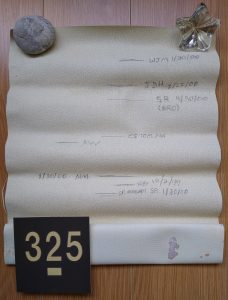 My last year of undergrad, I lived in (you guessed it!) room 325 of this particular house. I can’t quite recall how it started, but I believe there was an argument between two very petite friends of mine over which was taller, and the shorter of the two was having trouble admitting defeat. Since seeing is believing, measurements were made against the wall outside of my room and marked in pencil. Over the months of that final year, other friends and family were measured. By Commencement day, we had amassed a little collection.
My last year of undergrad, I lived in (you guessed it!) room 325 of this particular house. I can’t quite recall how it started, but I believe there was an argument between two very petite friends of mine over which was taller, and the shorter of the two was having trouble admitting defeat. Since seeing is believing, measurements were made against the wall outside of my room and marked in pencil. Over the months of that final year, other friends and family were measured. By Commencement day, we had amassed a little collection.
A year after I graduated, I came back to campus to attend the graduation of a good friend (RG, one of the two original height disputants). We went to visit the old dorm, and learned that it was soon to undergo a complete renovation / redecoration. I’m *pretty* sure there was already some preparatory work visible on the walls, which gave us inspiration and courage for what we were about to do, but that may just be a guilty conscience trying to soothe itself. We went up to visit my old hallway, and there were the height markings, just as we had left them. They were going to be replacing the wallpaper anyway, we reasoned. It was clear from the work they had already started. Someone (not me!) produced a pocket knife. It was all done surprisingly quickly and easily. We rolled up the strip of wallpaper we had liberated / salvaged / preserved, and at the last minute, someone (okay, it was me this time) gave the plastic number plaque outside of my old room a good, sharp yank (I mean, in for a penny…). All that to say, memory and nostalgia are very, very powerful forces. They can even turn a venerable college ceremony into a heist and the mildest of future librarians into a scofflaw.
No CommentsPosted in Collections, Exhibitions, Frontpage Exhibition, Research and learning | Tagged with show and tell
Five favourite fairy tales, part XII
Posted on June 5, 2020 @4:32 pm by cshriver
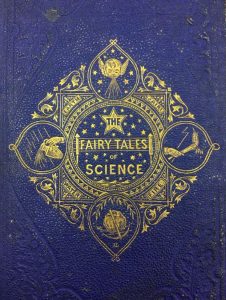
“The Fairy Tales of Science” ( PZ6 1866 .B76)
Thank you for joining us for this week’s Friday fairy tales blog post!
Even though the Rare Books and Special Collections reading room is currently closed, we’ve been excited to share over the past couple of months the delightful results of a student assignment undertaken during the winter 2020 term for the English course “The Victorian Fairy Tale: Text and Image”.
For this assignment, Professor Pamela Dalziel asked her students to “choose five illustrated Victorian fairy tales available in Rare Books and Special Collections that you would like to have in your personal collection.” Some of Professor Dalziel’s students were kind enough to share their final selections with the public through the RBSC blog, some anonymously and some with author credit.
These two will likely be the last student assignment we’ll be sharing through the blog, and we hope you have enjoyed them as much as we have! Be sure to read all of the fairy tale assignments shared by Professor Dalziel’s students and stop by RBSC to see some of the books for yourself once the RBSC reading room has reopened.
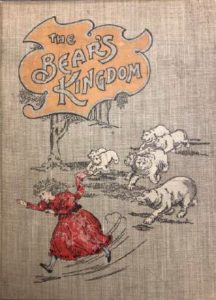
“The Bear’s Kingdom” (PZ6 1897 .R644)
Five fairy tale selections, part XII:
- Science fairy tales, Turkish fairy tales, delightful nonsense, fairy mythology, and water-babies
- Wymps, heroes, bears, pink fairies, and peeps into fairyland
No Comments
Posted in Announcements, Collections, Exhibitions, Frontpage Exhibition, Research and learning | Tagged with five fairy tales
Five favourite fairy tales, part XI
Posted on May 29, 2020 @5:17 pm by cshriver
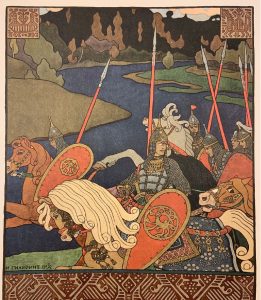
From “Volʹga” (PZ63.7 .V65 1904)
Happy Friday, and welcome back for this week’s Friday fairy tales blog post!
Even though the Rare Books and Special Collections reading room is currently closed, we’re excited to share the delightful results of a student assignment undertaken during the winter 2020 term for the English course “The Victorian Fairy Tale: Text and Image.”
For this assignment, Professor Pamela Dalziel asked her students to “choose five illustrated Victorian fairy tales available in Rare Books and Special Collections that you would like to have in your personal collection.” Some of Professor Dalziel’s students were kind enough to share their final selections with the public through the RBSC blog, some anonymously and some with author credit. Be sure to read all of the fairy tale assignments shared by Professor Dalziel’s students.
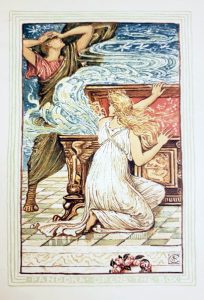
From “A Wonder Book for Girls and Boys” (PZ6 1892 .H3)
We hope you enjoy these charming fairy tale selections and will perhaps be inspired to stop by RBSC to see some of the books for yourself once the RBSC reading room has reopened.
Five fairy tale selections, part XI:
- Of “Monsters” and Men: King Frost, Volʹga, golden birds, green serpents, and cursed ladies
- Argonauts, were-wolves, kind ogres, Pandora, and the snark
Posted in Announcements, Collections, Exhibitions, Frontpage Exhibition, Research and learning | Tagged with five fairy tales
Five favourite fairy tales, part X
Posted on May 22, 2020 @4:42 pm by cshriver
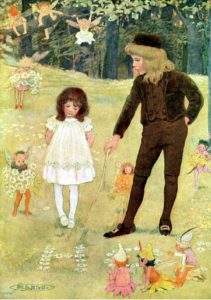
From “Mopsa, the Fairy” (PZ6 1910 I533)
We’re glad to have you back for our new tradition on the RBSC blog: Friday fairy tales!
Even though the Rare Books and Special Collections reading room is currently closed, we’re excited to share the delightful results of a student assignment undertaken during the winter 2020 term for the English course “The Victorian Fairy Tale: Text and Image.”
For this assignment, Professor Pamela Dalziel asked her students to “choose five illustrated Victorian fairy tales available in Rare Books and Special Collections that you would like to have in your personal collection.” Some of Professor Dalziel’s students were kind enough to share their final selections with the public through the RBSC blog, some anonymously and some with author credit. Be sure to read all of the fairy tale assignments shared by Professor Dalziel’s students.

From “The Three Little Kittens” (PZ4.9.B2247 Th 1862)
We hope you enjoy these charming fairy tale selections and will perhaps be inspired to stop by RBSC to see some of the books for yourself once the RBSC reading room has reopened.
Five fairy tale selections, part X:
- Magic fishbones, Prince Prigio, Mopsa the Fairy, the earthly paradise, and Sa’-Zada tales
- Wymps, riding hoods, Mother Goose, little kittens, and dancing princesses
No Comments
Posted in Announcements, Collections, Exhibitions, Frontpage Exhibition, Research and learning | Tagged with five fairy tales
Celebrating Nurses and Health Care Professionals at RBSC
Posted on May 13, 2020 @12:32 pm by cshriver
By Krisztina Laszlo, Archivist, Rare Books and Special Collections
“To know even one life has breathed easier because you have lived; that is to have succeeded.” — Ralph Waldo Emerson
Every evening at 7:00 pm Vancouverites head to their windows and balconies to cheer, clap, ring bells, bang pot lids together, and make noise in appreciation for the work of our health care professionals and other essential workers. The effort in my neighbourhood (Mount Pleasant) might not equal the incredible volume from the West End, but we do well considering we do not have the same population density. There is someone on my block with a saxophone, who plays every night and I am certain there are also cowbells in the distance.
This outpouring of support and love for the brave women and men on the front lines of the COVID-19 response often brings tears to my eyes. It reminds me of the many nurses and care aids I have encountered through my life. The ones who looked after my mom with kindness and compassion through the last years of her life, of my mother who spent time as a nurse’s aid when she was a young refugee in Victoria, and the retired nurses I’ve worked with who keep up the British Columbia History of Nursing Archives. I am astounded and humbled by the work done by all of these incredible people past and present, and I am grateful beyond any way I can express with words for their continued and sustained efforts during the present crisis.
As an archivist, I wonder how I can positively contribute to the current situation. My role is to preserve evidence from the past, and to ensure it is accessible to future generations. Like most of my colleagues across Canada, I am working from home, social distancing, washing my hands, and engaging in all the other steps necessary to slow the spread of COVID-19 and protect the vulnerable around us. In light of current events and the focus on medical aid, I thought this would be an appropriate time to shine a spotlight on our historic documents relating to health care, and particularly on the nursing profession.
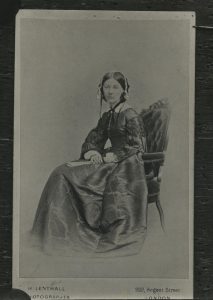
Photograph of Florence Nightingale Portrait. RBSC-ARC-1734-01-089-BC-2166-06.
Although the practice of nursing has been with us for centuries and remained predominantly female up to the current era, prior to this women were expected to tend only to members of their families. White upper middle class women did not care for the sick, dying or invalid strangers. It was in this context that Florence Nightingale, the most well known nurse of all, emerged. Nightingale defied her social standing as a wealthy daughter of a notable British family to advocate for, and create, Nursing as a profession for educated women based on the scientific principles of the day. At a time when women had few career options, this was a radical undertaking. Nightingale was able to put her theories into practice during the Crimean war (1853 – 1856), and with her success tending wounded soldiers the Nursing profession was firmly established.
For a detailed history of nursing see: https://www.britannica.com/science/nursing#ref36766
Rare Books and Special Collections is lucky to have a small cache of 88 letters written by Nightingale after her time tending the wounded of the Crimean War, and over a 100 received by her. The letters are digitized and available online for all to read and enjoy the words of this astounding woman. She made a commitment to help the wounded, and to training women to take up this work, a legacy we now celebrate daily.
https://open.library.ubc.ca/collections/florence
http://rbscarchives.library.ubc.ca/index.php/florence-nightingale-letters-collection
A compatriot, and close friend, of Nightingale is Sister Mary Gonzaga (Georgina Barrie), a Sister of Mercy from Bermondsey, England. She accompanied Nightingale to Crimea to nurse sick and wounded British soldiers as one of the Catholic nuns who volunteered for the mission and was unpaid for her work. Nightingale nicknamed her “Cardinal” in her letters, and Barrie’s nickname for Nightingale was “Pope.” Of her letters at UBC, 15 are written approximately a month apart during the war and discuss conditions in Crimea and request various supplies and items. After the Crimean War, Barrie founded the Hospital of Saint Elizabeth for Incurables in London in 1856.
http://rbscarchives.library.ubc.ca/index.php/sister-mary-gonzaga-georgiana-barrie-collection
- Sandbags instead of handbags – Lady ambulance drivers in France. RBSC-ARC-1636-BC-1763-0550.
- Lady ambulance drivers passing through a French village. RBSC-ARC-1636-BC-1763-0548.
Moving into the Twentieth Century, we house letters written by Martha May Beardmore (née Wilson), who was an English nurse who aided the British during World War I. In 1914, when Britain declared war on Germany. Beardmore settled her affairs in Regina and moved back to England to join the Queen Alexandra’s Imperial Military Nursing Service. As part of the Military Nursing Service, she aided efforts in France and the Balkan countries. Allegedly, she also ended up in the Palace of the Tsar of Russia and became a nurse to Grigori Rasputin. She ended up moving to France and then Belgium where she worked under noted nurse Edith Cavell. Our World War 1 British Press Photo collection contains images of nurses serving in France, which gives a sense of the conditions that Beardmore would have worked in.
http://rbscarchives.library.ubc.ca/index.php/martha-may-beardmore-collection

Saskatchewan million dollar campaign, June 17, 1922. SPAM461C.
Representing nursing during the Second World War is a photograph album compiled by Katherine Watson Emery, who was born in New Brunswick Canada in 1900. She moved to Vancouver, where she trained as a nurse. In 1944, she went into overseas service with the St. John Ambulance Brigade of Canada to tend to wounded during World War 2. She returned to Canada on September 25th 1945. The records document Emery’s service as a nurse during World-War 2, as well as her experiences of World-War 1, and her life and career as a nurse in Vancouver and New Brunswick.
http://rbscarchives.library.ubc.ca/index.php/katherine-emery-fonds
Not all of our nursing archives relate to wartime experiences, but also focus on practice in British Columbia. Mabel Clara Taylor was born in Eccleshall, England on the 1st of March 1891 to parents Joseph and Elizabeth Taylor. In her youth, she immigrated to Vancouver, British Columbia, where she studied nursing. In February of 1923, she graduated with a diploma in nursing from Vancouver General Hospital. Over the next three decades, she worked at various hospitals including the Prince Rupert General Hospital, the Essondale Mental Hospital, the Abbotsford General Hospital, the Mission Memorial Hospital, the Miller Bay Indian Hospital, the Royal Jubilee Hospital, the Oak Lodge Private Hospital, the Terrace Red Cross Outpost Hospital, the Children’s Hospital and the Nanaimo Indian Hospital.

[Chinese hospital clinic]. CC-PH-10640.
http://rbscarchives.library.ubc.ca/index.php/mabel-clara-taylor-fonds
Since 2019, Rare Books and Special Collections has been working with the British Columbia History of Nursing Society (BCHNS) on an exciting project to transfer their archival collections to the UBC Library. The BCHNS houses an extensive archive of nursing history in British Columbia, including records of individual nurses and nursing groups and associations. These materials cover the entire history of the profession in this province, including the development of nursing education and training. The archive is unparalleled in its coverage of this topic, and extensive in scope (it includes 22 meters of textual records, 270 audio recordings of oral histories, and more). We were weeks away from physically transferring the materials to RBSC when UBC switched to remote work due to COVID-19. When we return to campus, this acquisition will be a priority, especially considering the interest in this area engendered by the current focus on healthcare work.
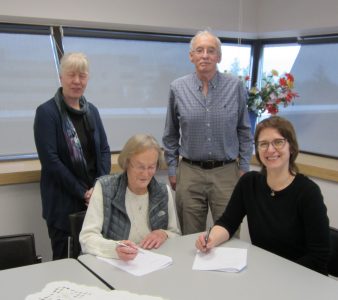
Nan Martin, BCHNS Chair of Succession Planning Task Group, and Krisztina Laszlo, Archivist, RBSC at official signing of agreement to transfer the BCHNS Archives to UBC Library on January 24, 2020. Francis Mansbridge, BCHNS Archivist, and Geertje Boschma of the UBC School of Nursing as witnesses.
“I attribute my success to this; I never gave nor took any excuse.” — Florence Nightingale
While the Rare Books and Special Collections reading room is currently closed, researchers interested in nursing history can access additional digitized content held by the UBC Library here: https://open.library.ubc.ca/collections/historyofnursinginpacificcanada
Please check the UBC Library homepage and the Rare Books and Special Collections homepage for future updates about reading room operations.
Posted in Collections, Exhibitions, Frontpage Exhibition, Research and learning | Tagged with
